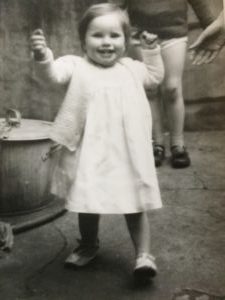
When it comes to memories, we are all unreliable narrators. The human brain will go to great lengths in order to create a coherent sense of self, sometimes inventing things that never happened and even people who don’t exist simply to hold the story together.
Memory is not like a video camera. It reframes and edits events to fit our current map of the world. So next time you go for a walk down memory lane, remember the words of the late neurologist Oliver Sacks: “Frequently, our only truth is narrative truth – the stories we tell each other, and ourselves – the stories we continually re-categorise and refine.”
But there is something much more undeniable about a photograph. It is a record of a moment in time. We may create a fanciful story to go with it, but the camera never lies. That’s why I love using old photographs as story prompts – especially early childhood photos.
As we always recreate memories through the lens of the present moment, a faded picture can lead us on a journey to connect who were were then with who we are now.
I tried this recently with a photo that my dad took in our back yard in East Dulwich, London (we didn’t have a garden) when I was a toddler – circa 1958. I can’t say for sure but it looks as if it might be one of the first times I walked by myself.
I have no idea what that metal contraption is that you can see next to me – perhaps an archaic labour-saving device, possibly the pot my mum used to boil nappies. Imagine that.
You can see my mum’s hand on the right and my sister in the background, waiting to catch me if I fall. But the look of absolute unconfined joy on my face would suggest that a) I’m loving this walking thing and I’m pretty determined to nail it; b) I have no intention of asking for help; and c) I’m barrelling towards my dad, who is almost certainly encouraging me every step of the way.
I’m still a big fan of this walking thing (especially in the Black Mountains of Wales); I’m a pretty determined and resilient person; and I’m still dysfunctionally independent and find it hard to ask for help, so not much has changed there. The big change is that my dad is no longer in the picture – he has been gone for almost 17 years.
There’s a whole story to be told about how I’d have loved him to have carried on encouraging me every step of the way, but that was made much harder when he had a stroke at 46. I grieve for the loss of all those moments when he could have been there rooting for me but wasn’t able to do so.
This one snapshot says so much about my character and what I would become. And I can look back at it now and tell stories about it that add meaning and richness to my personal narrative.
Try it. Dig out some old photos and see which one you’re drawn to. Sit with it for a while. What story is it trying to tell you? What message does the younger version of you have for you right now? What meaning can you make from it?
Memory might be unreliable but the meaning you make from this exercise provides something you can rely on.
- If you would like to explore your story and create new meaning, contact me at info@beverleyglick.com to arrange a free 30-minute Story Insight Breakthrough Session.
Hi Beverley,
Thank you for these thoughts. It has helped me organise mine as I am currently doing a fascinating course called, “I remember”
The third assignment involves describing a photo in my possession that is a memorial in a sense that many in the setting and even the setting has now gone or changed.
I am using a photo from 50 years ago, it elicits so many memories but many of which, have over the years been added to or parts just deleted by time.
It raises the question about the authenticity of our recall – thankfully I can still discuss the photo along with unique thoughts and much nostalgia with others in the frame.
The link to Oliver Sacks was useful too.